ASUS V2-P5P43, V3-P5P43 User Manual
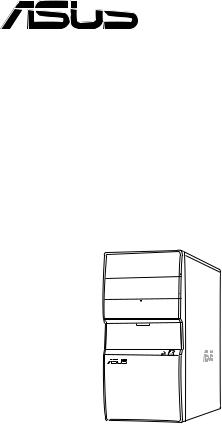

 ®
®
V-Series P5P43
ASUS PC (Desktop Barebone)
User Manual

E4214
First Edition V1
January 2009
Copyright © 2009 ASUSTeK Computer INC. All Rights Reserved.
No part of this manual, including the products and software described in it, may be reproduced, transmitted, transcribed, stored in a retrieval system, or translated into any language in any form or by any means, except documentation kept by the purchaser for backup purposes, without the express written permission of ASUSTeK Computer INC. (“ASUS”).
Product warranty or service will not be extended if: (1) the product is repaired, modified or altered, unless such repair, modification of alteration is authorized in writing byASUS; or (2) the serial number of the product is defaced or missing.
ASUS PROVIDES THIS MANUAL “AS IS” WITHOUT WARRANTY OF ANY KIND, EITHER EXPRESS OR IMPLIED, INCLUDING BUT NOT LIMITED TO THE IMPLIED WARRANTIES OR CONDITIONS OF MERCHANTABILITY OR FITNESS FOR A PARTICULAR PURPOSE. IN NO EVENT SHALL ASUS, ITS DIRECTORS, OFFICERS, EMPLOYEES OR AGENTS BE LIABLE FOR ANY INDIRECT, SPECIAL, INCIDENTAL, OR CONSEQUENTIAL DAMAGES (INCLUDING DAMAGES FOR LOSS OF PROFITS, LOSS OF BUSINESS, LOSS OF USE OR DATA, INTERRUPTION OF BUSINESS AND THE LIKE), EVEN IF ASUS HAS BEEN ADVISED OF THE POSSIBILITY OF SUCH DAMAGES ARISING FROM ANY DEFECT OR ERROR IN THIS MANUAL OR PRODUCT.
SPECIFICATIONS AND INFORMATION CONTAINED IN THIS MANUAL ARE FURNISHED FOR INFORMATIONAL USE ONLY, AND ARE SUBJECT TO CHANGE AT ANY TIME WITHOUT NOTICE, AND SHOULD NOT BE CONSTRUED AS A COMMITMENT BY ASUS. ASUS ASSUMES NO RESPONSIBILITY OR LIABILITY FOR ANY ERRORS OR INACCURACIES THAT MAY APPEAR IN THIS MANUAL, INCLUDING THE PRODUCTS AND SOFTWARE DESCRIBED IN IT.
Products and corporate names appearing in this manual may or may not be registered trademarks or copyrights of their respective companies, and are used only for identification or explanation and to the owners’ benefit, without intent to infringe.
ii

ASUS contact information
ASUSTeK COMPUTER INC.
Address |
15 Li-Te Road, Peitou, Taipei, Taiwan 11259 |
Telephone |
+886-2-2894-3447 |
Fax |
+886-2-2890-7798 |
info@asus.com.tw |
|
Web site |
www.asus.com.tw |
Technical Support
Telephone |
+86-21-38429911 |
Online support |
support.asus.com |
ASUS COMPUTER INTERNATIONAL (America)
Address |
800 Corporate Way, Fremont, CA94539, USA |
Telephone |
+1-510-739-3777 |
Fax |
+1-510-608-4555 |
Web site |
usa.asus.com |
Technical Support
Telephone |
+1-812-282-2787 |
Support fax |
+1-812-284-0883 |
Online support |
support.asus.com |
ASUS COMPUTER GmbH (Germany and Austria)
Address |
Harkort Str. 21-23, D-40880 Ratingen, Germany |
Telephone |
+49-2102-95990 |
Fax |
+49-2102-959911 |
Web site |
www.asus.de |
Online contact |
www.asus.de/sales |
Technical Support
Telephone |
+49-1805-010923 |
Support Fax |
+49-2102-9599-11 |
Online support |
support.asus.com |
iii

Contents
ASUS contact information |
.......................................................................... iii |
Notices........................................................................................................ |
vii |
Safety information..................................................................................... |
viii |
About this guide.......................................................................................... |
ix |
System package contents.......................................................................... |
xi |
Chapter 1 |
System introduction |
|
|
1.1 |
Welcome! |
....................................................................................... |
1-2 |
1.2 |
Front panel.................................................................................... |
1-2 |
|
1.3 |
Rear panel..................................................................................... |
1-3 |
|
|
Voltage selector.............................................................................. |
1-5 |
|
1.4 |
Internal components.................................................................... |
1-6 |
|
Chapter 2 |
Basic installation |
|
|
2.1 |
Preparation.................................................................................... |
2-2 |
|
2.2 |
Before you proceed...................................................................... |
2-3 |
|
2.3 |
Removing the side cover and frontpanel assembly.................. |
2-4 |
|
2.4 |
Central Processing Unit (CPU).................................................... |
2-5 |
|
|
2.4.1 |
Overview.......................................................................... |
2-5 |
|
2.4.2 |
Installing CPU.................................................................. |
2-5 |
|
2.4.3 |
Installing the CPU fan and heatsink assembly................ |
2-8 |
|
2.4.4 |
Uninstalling the CPU heatsink and fan assembly............ |
2-9 |
2.5 |
Installing a DIMM........................................................................ |
2-10 |
|
|
2.5.1 |
Memory configurations................................................... |
2-11 |
|
2.5.2 |
Installing a DDR2 DIMM................................................ |
2-18 |
|
2.5.3 |
Removing a DIMM......................................................... |
2-18 |
2.6 |
Expansion slots.......................................................................... |
2-19 |
|
|
2.6.1 |
PCI slots........................................................................ |
2-19 |
|
2.6.2 |
PCI Express x1 slot....................................................... |
2-19 |
|
2.6.3 |
PCI Express x16 slot..................................................... |
2-19 |
|
2.6.4 |
Installing an expansion card.......................................... |
2-20 |
|
2.6.5 |
Configuring an expansion card...................................... |
2-20 |
|
2.6.6 |
Interrupt assignments.................................................... |
2-21 |
2.7 |
Installing storage drives............................................................ |
2-23 |
|
|
2.7.1 |
Installing an optical drive............................................... |
2-23 |
iv
Contents
|
2.7.2 |
Installing a floppy disk drive........................................... |
2-23 |
|
2.7.3 |
Installing a hard disk drive............................................. |
2-24 |
2.8 |
Reinstalling the front panel assembly and side cover............ |
2-25 |
|
Chapter 3 |
Starting up |
|
|
3.1 |
Installing an operating system.................................................... |
3-2 |
|
3.2 |
Powering up.................................................................................. |
3-2 |
|
3.3 |
Support DVD information............................................................. |
3-2 |
|
|
3.3.1 |
Running the support DVD................................................ |
3-3 |
|
3.3.2 |
Utilities menu................................................................... |
3-4 |
|
3.3.3 |
Manual menu................................................................... |
3-7 |
|
3.3.4 |
Make Disk menu.............................................................. |
3-8 |
|
3.3.5 |
ASUS Contact information............................................... |
3-9 |
|
3.3.5 |
Other information........................................................... |
3-10 |
3.4 |
Software information.................................................................. |
3-12 |
|
|
ASUS PC Probe II........................................................................ |
3-12 |
|
Chapter 4 |
Motherboard introductiomn |
|
|
4.1 |
Introduction................................................................................... |
4-2 |
|
4.2 |
Motherboard layout...................................................................... |
4-2 |
|
4.3 |
Jumpers |
......................................................................................... |
4-3 |
4.3 |
Connectors.................................................................................... |
4-4 |
|
Chapter 5 |
BIOS setup |
|
|
5.1 |
Managing and updating your BIOS............................................. |
5-2 |
|
|
5.1.1 |
ASUS Update utility......................................................... |
5-2 |
|
5.1.2 |
Creating a bootable floppy disk....................................... |
5-5 |
|
5.1.3 |
ASUS EZ Flash 2 utility................................................... |
5-6 |
|
5.1.4 |
AFUDOS utility................................................................ |
5-7 |
|
5.1.5 |
ASUS CrashFree BIOS 3 utility....................................... |
5-9 |
5.2 |
BIOS setup program................................................................... |
5-10 |
|
|
5.2.1 |
BIOS menu screen......................................................... |
5-11 |
|
5.2.2 |
Menu bar........................................................................ |
5-11 |
|
5.2.3 |
Navigation keys.............................................................. |
5-11 |
|
5.2.4 |
Menu items.................................................................... |
5-12 |
|
5.2.5 |
Sub-menu items............................................................ |
5-12 |
|
5.2.6 |
Configuration fields........................................................ |
5-12 |
|
|
|
|

Contents
|
5.2.7 |
Pop-up window.............................................................. |
5-12 |
|
5.2.8 |
Scroll bar....................................................................... |
5-12 |
|
5.2.9 |
General help.................................................................. |
5-12 |
5.3 |
Main menu................................................................................... |
5-13 |
|
|
5.3.1 |
System Time.................................................................. |
5-13 |
|
5.3.2 |
System Date.................................................................. |
5-13 |
|
5.3.3 |
Legacy DisketteA.......................................................... |
5-13 |
|
5.3.4 |
SATA1~6....................................................................... |
5-14 |
|
5.3.5 |
Storage Configuration.................................................... |
5-15 |
|
5.3.6 |
System Information........................................................ |
5-16 |
5.4 |
Advanced menu.......................................................................... |
5-17 |
|
|
5.4.1 |
Jumperfree Configuration.............................................. |
5-17 |
|
5.4.2 |
CPU Configuration......................................................... |
5-20 |
|
5.4.3 |
Chipset.......................................................................... |
5-22 |
|
5.4.4 |
Onboard Devices Configuration.................................... |
5-23 |
|
5.4.5 |
USB Configuration......................................................... |
5-25 |
|
5.4.6 |
PCI PnP......................................................................... |
5-26 |
5.5 |
Power menu................................................................................ |
5-27 |
|
|
5.5.1 |
Suspend Mode.............................................................. |
5-27 |
|
5.5.2 |
ACPI 2.0 Support........................................................... |
5-27 |
|
5.5.3 |
ACPIAPIC Support....................................................... |
5-27 |
|
5.5.4 |
APM Configuration........................................................ |
5-28 |
|
5.5.5 |
Hardware Monitor.......................................................... |
5-29 |
5.6 |
Boot menu................................................................................... |
5-30 |
|
|
5.6.1 |
Boot Device Priority....................................................... |
5-30 |
|
5.6.2 |
Boot Settings Configuration........................................... |
5-31 |
|
5.6.3 |
Security.......................................................................... |
5-32 |
5.7 |
Tools menu.................................................................................. |
5-34 |
|
|
5.7.1 |
ASUS EZ Flash 2.......................................................... |
5-34 |
|
5.7.2 |
Express Gate................................................................. |
5-35 |
|
5.7.3 |
AI NET 2........................................................................ |
5-36 |
5.8 |
Exit menu..................................................................................... |
5-37 |
|
vi

Notices
Federal Communications Commission Statement
This device complies with Part 15 of the FCC Rules. Operation is subject to the following two conditions:
•This device may not cause harmful interference, and
•This device must accept any interference received including interference that may cause undesired operation.
This equipment has been tested and found to comply with the limits for a Class B digital device, pursuant to Part 15 of the FCC Rules. These limits are designed to provide reasonable protection against harmful interference in a residential installation. This equipment generates, uses and can radiate radio
frequency energy and, if not installed and used in accordance with manufacturer’s instructions, may cause harmful interference to radio communications. However, there is no guarantee that interference will not occur in a particular installation. If this equipment does cause harmful interference to radio or television reception, which can be determined by turning the equipment off and on, the user is encouraged to try to correct the interference by one or more of the following measures:
•Reorient or relocate the receiving antenna.
•Increase the separation between the equipment and receiver.
•Connect the equipment to an outlet on a circuit different from that to which the receiver is connected.
•Consult the dealer or an experienced radio/TV technician for help.
The use of shielded cables for connection of the monitor to the graphics card is required to assure compliance with FCC regulations. Changes or modifications to this unit not expressly approved by the party responsible for compliance could void the user’s authority to operate this equipment.
Canadian Department of Communications Statement
This digital apparatus does not exceed the Class B limits for radio noise emissions from digital apparatus set out in the Radio Interference Regulations of the Canadian Department of Communications.
This class B digital apparatus complies with Canadian ICES-003.
vii

Safety information
Electrical safety
•To prevent electric shock hazard, disconnect the power cable from the electrical outlet before relocating the system.
•When adding or removing devices to or from the system, ensure that the power cables for the devices are unplugged before the signal cables are connected.
•If the power supply is broken, do not try to fix it by yourself. Contact a qualified service technician or your retailer.
Operation safety
•Before installing devices into the system, carefully read all the documentation that came with the package.
•Before using the product, ensure that all cables are correctly connected and the power cables are not damaged. If you detect any damage, contact your dealer immediately.
•To avoid short circuits, keep paper clips, screws, and staples away from connectors, slots, sockets, and circuitry.
•Avoid dust, humidity, and extreme temperatures. Do not place the product in any area where it may become wet. Place the product on a stable surface.
•When using the product, do not block any air inlet/outlet in the chassis.
•The maximum environmental temperature is 35ºC.
•If you encounter technical problems with the product, contact a qualified service technician or your retailer.
Lithium-Ion Battery Warning
CAUTION: Danger of explosion if battery is incorrectly replaced. Replace only with the same or equivalent type recommended by the manufacturer. Dispose of used batteries according to the manufacturer’s instructions.
VORSICHT: Explosionsgetahr bei unsachgemäßen Austausch der Batterie.
Ersatz nur durch denselben oder einem vom Hersteller empfohlenem
ähnljchen Typ. Entsorgung gebrauchter Batterien nach Angaben des Herstellers.
LASER PRODUCT WARNING
CLASS 1 LASER PRODUCT
viii

About this guide
Audience
This guide provides general information and installation instructions about the
ASUS Vintage V4-Series P5P43 barebone system. This guide is intended for experienced users and integrators with hardware knowledge of personal computers.
How this guide is organized
This guide contains the following parts:
1.Chapter 1: System introduction
This chapter gives a general description of the ASUS
V4-Series P5P43. The chapter lists the system features, including introduction on the front and rear panel, and internal components.
2.Chapter 2: Basic installation
This chapter provides step-by-step instructions on how to install components in the system.
3.Chapter 3: Starting up
This chapter helps you power up the system and install drivers and utilities from the support DVD.
4.Chapter 4: Motherboard introduction
This chapter gives information about the motherboard that comes with the system. This chapter includes the motherboard layout, jumper settings, and connector locations.
5.Chapter 5: BIOS setup
This chapter tells you how to change system settings through the BIOS Setup menus and describes the BIOS parameters.
ix

Conventions used in this guide
To ensure that you perform certain tasks properly, take note of the following symbols used throughout this guide.
WARNING: Information to prevent injury to yourself when trying to complete a task.
CAUTION: Information to prevent damage to the components when trying to complete a task.
IMPORTANT: Instructions that you MUST follow to complete a task.
NOTE: Tips and additional information to aid in completing a task.
Where to find more information
Refer to the following sources for additional information and for product and software updates.
1.ASUS Websites
The ASUS websites worldwide provide updated information on ASUS hardware and software products. Refer to the ASUS contact information.
2.Optional Documentation
Your product package may include optional documentation, such as warranty flyers, that may have been added by your dealer. These documents are not part of the standard package.

System package contents
Check your V4-Series P5P43 system package for the following items.
Item description
1.ASUS V4-Series P5P43 barebone system with
•ASUS motherboatd
•Power supply unit
•ASUS chassis
2.Cable
•AC power cable
3.Support DVD
4.User guide
5.Telecom Adapter Card (Optional)
If any of the items is damaged or missing, contact your retailer immediately.
xi

xii
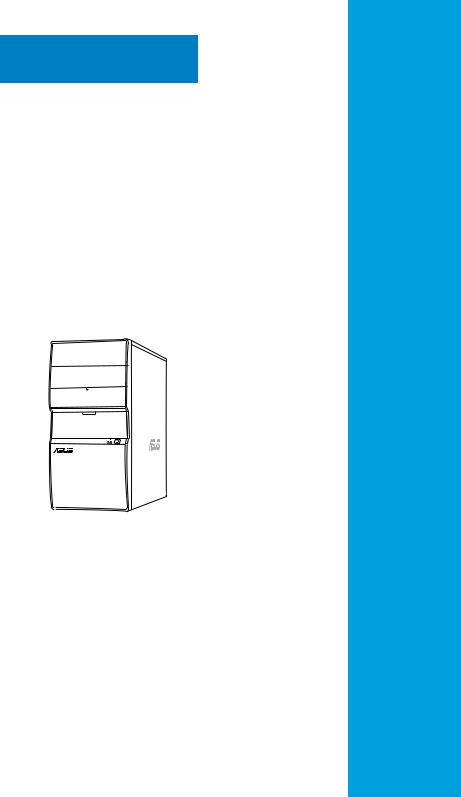
Chapter 1
This chapter gives you a general description of the ASUS
V4-Series P5P43. The chapter lists the system features including introduction on the front and rear panel, and internal components.
System introduction
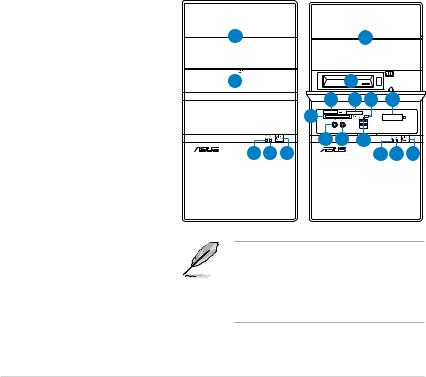
1.1Welcome!
Thank you for buying theASUS V4-Series P5P43!
TheASUS V4-Series P5P43 is an all-in-one barebone system with a versatile home entertainment feature.
The system comes in a stylish casing and powered by the ASUS motherboard that supports the Intel® Core™2 Extreme / Core™2 Duo / Core™2 Quad / Pentium® D / Pentium® 4 / Celeron® D processors in the 775-land package.
The system supports up to 8 GB of system memory using DDR2-1066/800/667
DIMMs. High-resolution graphics via integrated graphics controller or PCI Express x16 slot, SerialATA, USB 2.0, and
8-channel audio feature the system and take you ahead in the world of power computing.
1.2Front panel
The front panel includes the optical drive bays, hard disk drive bay, power button, and I/O ports.
1. |
5.25-inch drive bay cover |
|
|
|
|
|
|
|
|
2. |
3.5-inch drive bay cover |
1 |
|
|
|
|
1 |
|
|
3. |
2.5-inch portable hard |
|
|
|
|
|
|
||
|
disk drive* |
|
|
|
|
|
|
|
|
4. |
MemoryStick®/Memory |
2 |
|
|
|
3 |
|
|
|
|
Stick Pro™ card slot |
|
|
|
|
|
|
||
|
|
|
|
4 |
5 |
6 |
7 |
|
|
5. |
Secure Digital™/ |
|
|
8 |
|
||||
|
|
|
|
|
|
|
|||
|
Multimedia Card slot |
|
|
|
|
|
|
|
|
6. |
Card reader LED |
|
|
9 |
10 |
|
11 |
|
|
7. |
Infrared window* |
|
12 13 |
14 |
|
|
|
12 13 |
14 |
8.CompactFlash®/ Microdrive™ card slot
9.Microphone port
10.Headphone port
11. |
USB 2.0 ports** |
• The portable hard disk drive and the |
|
12. |
HDD LED |
||
Infrared function are optional. |
|||
13. |
Power LED |
• Some models may have two additional |
|
14. |
Power button |
USB 2.0 ports and/or one IEEE 1394a |
|
|
|
port. |
1-2 |
Chapter 1: System introduction |
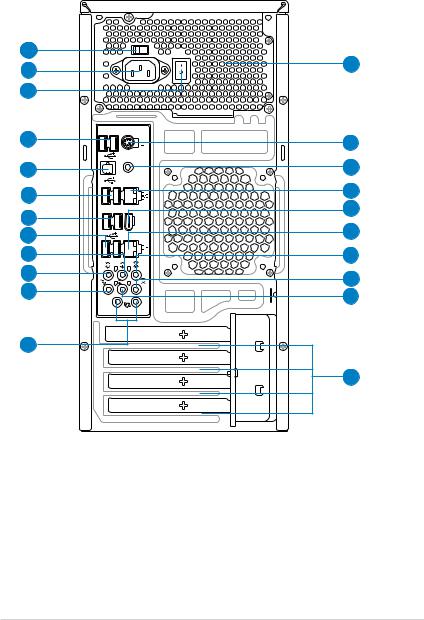
1.3Rear panel
The system rear panel includes the power connector and several I/O ports that allow convenient connection of devices.
1
2 |
3 |
4
5 |
OUT SPDIF |
6 |
|
7 |
1394 eSATA |
8 |
|
9 |
|
14
13
15
21
20
19
18
17
16
10
11
12
22
1.Voltage selector. This switch allows you to adjust the system input voltage according to the voltage supply in your area. See the section “Voltage selector” on page 1-6 before adjusting this switch.
2.Power connector. This connector is for the power cable and plug.
3.Power Switch. This switch is for switching on/off the power supply unit.
4.USB 2.0 ports. These two 4-pin Universal Serial Bus (USB) ports are available for connecting USB 2.0 devices.
ASUS V4-Series P5P43 |
1-3 |

5.Optical S/PDIF Out port. This port connects an external audio output device via an optical S/PDIF cable.
6.USB 2.0 ports. These two 4-pin Universal Serial Bus (USB) ports are available for connecting USB 2.0 devices.
7.External SATA ports. This port connects to an external Serial ATA hard disk drive.
DO NOT insert different connectors to the external SATA port.
8.USB 2.0 ports. These two 4-pin Universal Serial Bus (USB) ports are available for connecting USB 2.0 devices.
9.Rear Speaker Out port (black). This port connects the rear speakers in a
4-channel, 6-channel, or 8-channel audio configuration..
10.Center / Subwoofer port (orange). This port connects the center / subwoofer speakers.11. Line In port (light blue). This port connects the tape, CD, DVD player, or other audio sources.
12.Line Out port (green). This port connects a headphone or a speaker. In
4-channel, 6-channel, and 8-channel configuration, the function of this port becomes Front Speaker Out.
13Microphone port (pink). This port connects a microphone.
14.Side Speaker Out port (gray). This port connects the side speakers in an
8-channel audio configuration.
Refer to the audio configuration table below for the function of the audio ports in 2, 4, 6, or 8-channel configuration.
Audio 2, 4, 6, or 8-channel configuration
Port |
Headset |
4-channel |
6-channel |
8-channel |
|
2-channel |
|||||
|
|
|
|
||
Light Blue |
Line In |
Line In |
Line In |
Line In |
|
Green |
Line Out |
Front Speaker Out |
Front Speaker Out |
Front Speaker Out |
|
Pink |
Mic In |
Mic In |
Mic In |
Mic In |
|
Orange |
– |
– |
Center/Subwoofer |
Center/Subwoofer |
|
Black |
– |
Rear Speaker Out |
Rear Speaker Ou |
Rear Speaker Out |
|
Gray |
– |
– |
– |
Side Speaker Out |
15. Antenna jack. This jack is on the onboard wireless LAN module that allows you to set up a wireless network and exchange information with other wireless devices without tangling cables and wires. Connect the moveable omni-directional antenna to this jack.
16. LAN (RJ-45) port. This port allows Gigabit connection to a Local Area Network (LAN) through a network hub.
1-4 |
Chapter 1: System introduction |

17.IEEE 1394a port. This 6-pin IEEE 1394a port provides high-speed connectivity for audio/video devices, storage peripherals, PCs, or portable devices.
18.LAN (RJ-45) port. This port allows Gigabit connection to a Local Area Network (LAN) through a network hub.
19.Coaxial S/PDIF Out port. This port connects an external audio output device via a coaxial S/PDIF cable.
20.PS/2 keyboard port. This purple 6-pin connector is for a PS/2 keyboard.
21.Power supply unit fan vent. This vent is for the PSU fan that provides ventilation inside the power supply unit.
22.Expansion slot covers. Remove these covers when installing expansion cards.
Voltage selector
The PSU has a 115 V/230 V voltage selector switch located beside the power connector. Use this switch to select the appropriate system input voltage according to the voltage supply in your area.
If the voltage supply in your area is 100 127 V, set this switch to 115 V. If the voltage supply in your area is 200 240 V, set this switch to 230 V.
115V/230V |
Voltage selector |
Setting the switch to 115V in a 230V environment or 230V in a 115V environment will seriously damage the system!
ASUS V4-Series P5P43 |
1-5 |
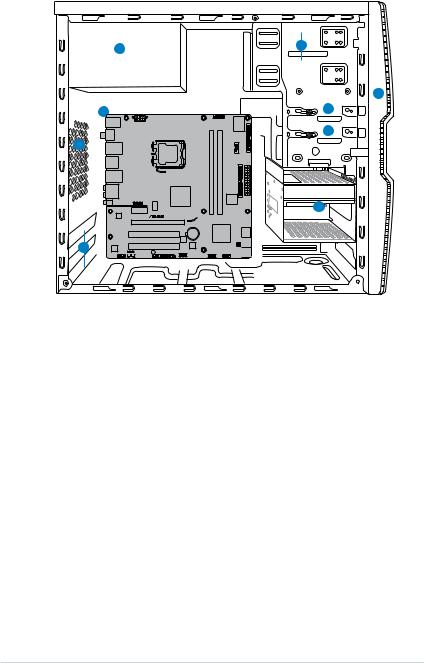
1.4Internal components
|
5 |
2 |
|
|
|
|
|
1 |
7 |
|
3 |
|
|
4 |
6



 9
9
P5QL-M DELUXE/WIFI-AP
8
1. |
Front panel cover |
5. |
Power supply unit |
2. |
5.25-inch optical drive bays |
6. |
Chassis fan slot |
3. |
2.5-inch portable hard disk drive bay |
7. |
ASUS motherboard |
|
(optional) |
8. |
Expansion slot metal brackets |
4. |
3.5-inch hard disk drive bay |
9. |
3.5-inch hard disk drive holder |
|
|
|
(optional) |
1-6 |
Chapter 1: System introduction |
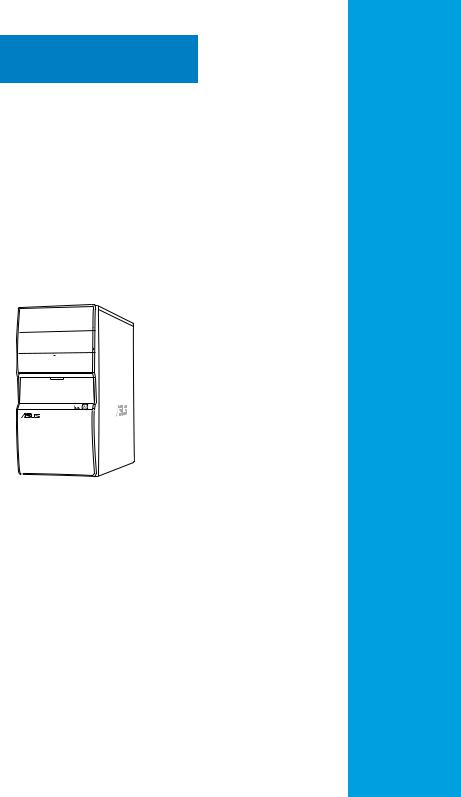
Chapter 2
This chapter provides step-by-step instructions on how to install components into the system.
Basic installation

2.1Preparation
Before you proceed, ensure that you have all the components you plan to install into the system.
Basic components to install
1.Central Processing Unit (CPU)
2.DDR2 Dual Inline Memory Module (DIMM)
3.Expansion cards
4.Hard disk drive
5.Optical disk drive
Tool
Phillips (cross) screw driver
2-2 |
Chapter 2: Basic installation |

2.2Before you proceed
Take note of the following precautions before you install components into the system.
•Unplug the power cables before you touch any component in the system.
• Use a grounded wrist strap, or touch a safely grounded object or a metal object, such as the power supply case, before handling components to avoid damaging them due to static electricity.
•Hold components by the edges to avoid touching the ICs on them.
•Whenever you uninstall any component, place it on a grounded antistatic pad or in the bag that came with the component.
•Before you install or remove any component, ensure that the ATX power supply is switched off or the power cable is detached from the power supply. Failure to do so may lead to personal injury and cause severe damage to the motherboard, peripherals, and components.
Onboard LED
The system motherboard comes with a standby power LED that lights up to indicate that the system is ON, in sleep mode, or in soft-off mode. This a reminder that you should shut down the system and unplug the power cable before removing or plugging in any motherboard component. The illustration below shows the location of the onboard LED.
SB_PWR
P5QL-M DELUXE/WIFI-AP
ON OFF
Standy Power Powered Off
P5QL-M DELUXE/WIFI-AP Onboard LED
ASUS V4-Series P5P43 |
2-3 |
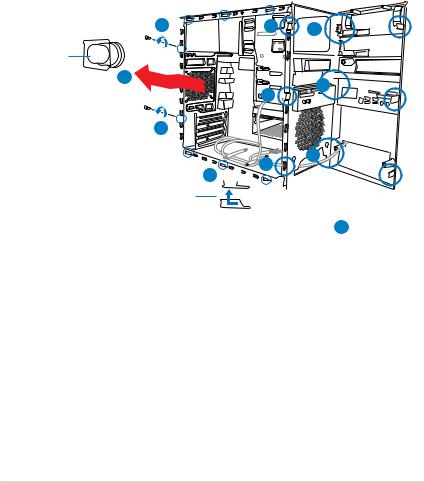
2.3Removing the side cover and front panel assembly
Follow the steps below to remove the side cover and front panel assembly.
1.Remove the cover screws on the rear panel.
2.Pull the side cover toward the rear panel until its hooks disengage from the chassis tab holes. Set the side cover aside.
3.Locate the front panel assembly hooks, then lift them until they disengage from the chassis.
4.Swing the front panel assembly to the right, until the hinge-like tabs on the right side of the assembly are exposed.
5.Remove the front panel assembly, then set it aside.
1 3
 4
4
Air duct |
|
|
|
2 |
|
3 |
4 |
|
|
||
|
|
|
|
1 |
|
|
|
|
|
3 |
4 |
|
2 |
|
|
|
|
|
|
Chassis tab holes |
|
|
|
4
2-4 |
Chapter 2: Basic installation |
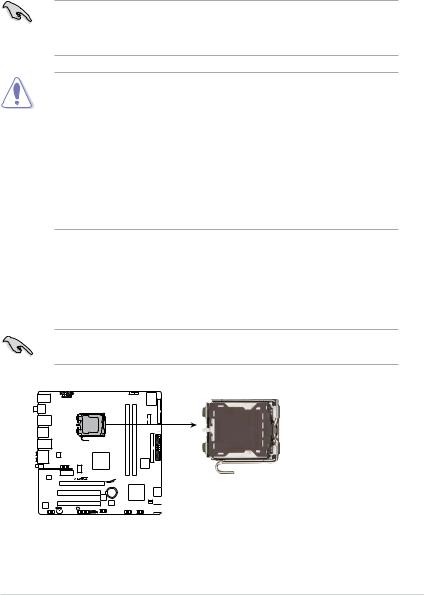
2.4Central Processing Unit (CPU)
2.4.1Overview
The motherboard comes with a surface mount LGA775 socket designed for the Intel® Core™2 Quad / Intel® Core™2 Extreme / Core™2 Duo / Pentium® Extreme / Pentium® D/ Pentium® 4 / Celeon® processors.
• Make sure that all power cables are unplugged before installing the CPU.
• Connect the chassis fan cable to the CHA_FAN connector to ensure system stability.
• Upon purchase of the motherboard, make sure that the PnP cap is on the socket and the socket contacts are not bent. Contact your retailer
immediately if the PnP cap is missing, or if you see any damage to the PnP cap/socket contacts/motherboard components. ASUS will shoulder the cost of repair only if the damage is shipment/transit-related.
•Keep the cap after installing the motherboard. ASUS will process Return
MerchandiseAuthorization (RMA) requests only if the motherboard comes with the cap on the LGA775 socket.
•The product warranty does not cover damage to the socket contacts resulting from incorrect CPU installation/removal, or misplacement/loss/ incorrect removal of the PnP cap.
2.4.2Installing CPU
To install a CPU:
1.Locate the CPU socket on the motherboard.
Before installing the CPU, make sure that the socket box is facing towards you and the load lever is on your left.
P5QL-M DELUXE/WIFI-AP
P5QL-M DELUXE/WIFI-AP CPU socket 775
ASUS V4-Series P5P43 |
2-5 |
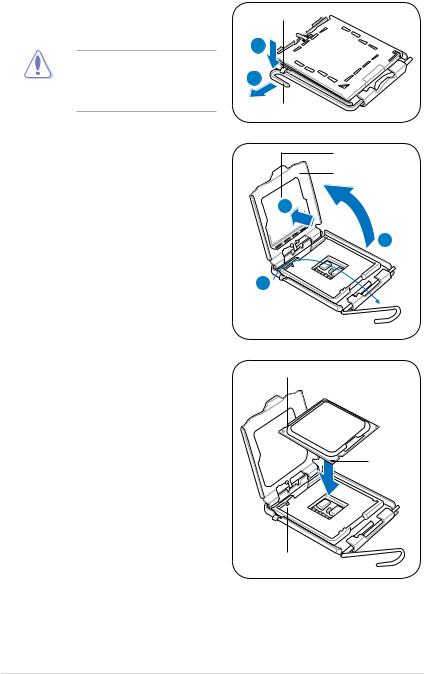
2.Press the load lever with your thumb
(A), then move it to the left (B) until it is released from the retention tab.
To prevent damage to the socket pins, do not remove the PnP cap unless you are installing a CPU.
Retention tab
A
B
Load lever
3.Lift the load lever in the direction of the arrow to a 135º angle.
4.Lift the load plate with your thumb and forefinger to a 100º angle (4A), then push the PnP cap from the load plate window to remove (4B).
PnP cap Load plate
4B 
4A
3
5.Position the CPU over the socket, ensuring that the gold triangle is on the bottom left corner of the socket then fit the socket alignment key into the CPU notch.
CPU notch
 Gold triangle
Gold triangle  mark
mark
Alignment key
2-6 |
Chapter 2: Basic installation |

6. Apply several drops of Thermal Interface Material to the exposed area of the CPU that the heatsink will be in contact with, ensuring that it is spread in an even thin layer.
Some heatsinks come with preapplied thermal paste. If so, skip this step.
DO NOT eat the Thermal Interface Material. If it gets into your eyes or touches your skin, ensure that you wash it off immediately, and seek professional medical help.
To prevent contaminating the thermal paste, DO NOT spread it with your finger directly.
7. |
Close the load plate (A), then push |
|
|
the load lever (B) until it snaps into |
A |
|
the retention tab. |
|
B
The motherboard supports Intel® LGA775 processors with the Intel® Enhanced Intel SpeedStep® Technology (EIST) and Hyper-Threading Technology.
ASUS V4-Series P5P43 |
2-7 |
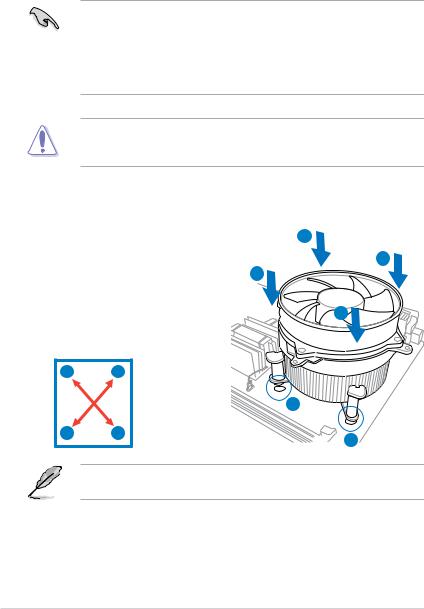
2.4.3Installing the CPU fan and heatsink assembly
The Intel® Pentium® 4 LGA775 processor requires a specially designed heatsink and fan assembly to ensure optimum thermal condition and performance.
•When you buy a boxed Intel® Pentium® 4 processor, the package
includes the CPU fan and heatsink assembly. If you buy a CPU separately, make sure that you use only Intel® certified multi directional heatsink and fan.
•Your Intel® Pentium® 4 LGA775 heatsink and fan assembly comes in a push-pin design and requires no tool to install.
If you purchased a separate CPU heatsink and fan assembly, make sure that the Thermal Interface Material is properly applied to the CPU heatsink or CPU before you install the heatsink and fan assembly.
To install the CPU heatsink and fan: |
|
|
1. Place the heatsink on top of the |
A |
|
installed CPU, ensuring that the four |
B |
|
fasteners match the holes on the |
||
B |
||
motherboard. |
||
2. Push down two fasteners at a time |
|
|
in a diagonal sequence to secure |
A |
|
the heatsink and fan assembly in |
|
|
place. |
|
A B
1
B |
A |
1 |
|
|
Orient the heatsink and fan assembly such that the CPU fan cable is closest to the CPU fan connector.
2-8 |
Chapter 2: Basic installation |
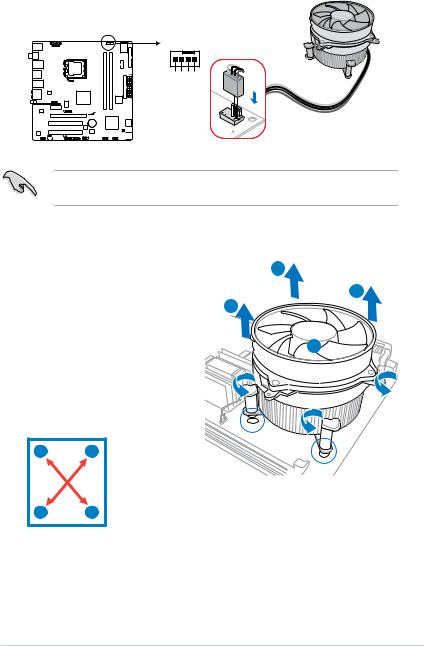
3.When the fan and heatsink assembly is in place, connect the CPU fan cable to the connector on the motherboard.
CPU_FAN |
GND
CPU FAN PWR
CPU FAN IN
CPU FAN PWM
P5QL-M DELUXE/WIFI-AP
P5QL-M DELUXE/WIFI-AP CPU fan connector
Do not forget to connect the CPU fan connector! Hardware monitoring errors can occur if you fail to plug this connector.
2.4.4Uninstalling the CPU heatsink and fan assembly
To uninstall the CPU heatsink and fan:
1.Disconnect the CPU fan cable from the CPU_FAN connector on the motherboard.
2.Rotate each fastener counterclockwise.
3.Pull up two fasteners at a time in a diagonal sequence to disengage the heatsink and fan assembly from the motherboard.
A
B
B
A
A B
BA
4.Remove the heatsink and fan assembly from the motherboard.
ASUS V4-Series P5P43 |
2-9 |
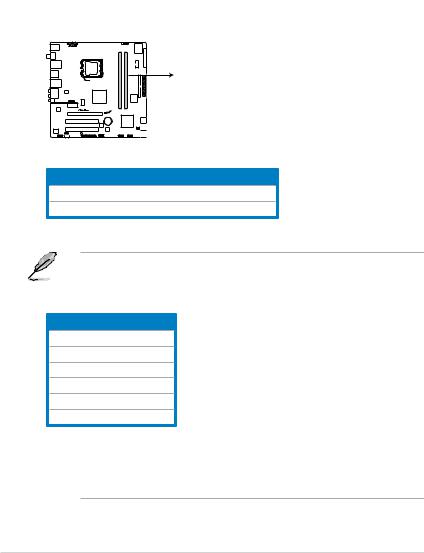
2.5Installing a DIMM
The motherboard comes with four Double Data Rate 2 (DDR2) Dual Inline Memory
Modules (DIMM) sockets.
The figure illustrates the location of the DDR2 DIMM sockets:
DIMM_B1
DIMM_A1
P5QL-M DELUXE/WIFI-AP
P5QL-M DELUXE/WIFI-AP 240-pin DDR2 DIMM sockets
Channel |
Sockets |
Channel A |
DIMM_A1 |
Channel B |
DIMM_B1 |
•This chipset officially supports DDR2-800 MHz. With theASUS Super
Memspeed Technology, this motherboard natively supports up to
DDR2-1066 MHz. See the table below.
FSB |
DDR2 |
1333 |
1066* |
1333 |
800 |
1333 |
667 |
1066 |
1066* |
1066 |
800 |
1066 |
667 |
•*If you install a DDR2-1066 memory module whose SPD is DDR2-800, make sure that you set the DRAM Frequency item in BIOS to
[DDR2-1066MHz]. See section 5.4.1 Jumperfree Configuration for details.
2-10 |
Chapter 2: Basic installation |

2.5.1Memory configurations
You may install 256 MB, 512 MB, 1 GB, and 2 GB unbuffered non ECC DDR2
DIMMs into the DIMM sockets.
Recommended Memory Configurations
• You may install varying memory sizes in ChannelAand Channel B. The system maps the total size of the lower-sized channel for the dual-channel configuration.Any excess memory from the higher-sized channel is then mapped for single-channel operation.
•Always install DIMMs with the same CAS latency. For optimum compatibility, it is recommended that you obtain memory modules from the same vendor.
•Due to the memory address limitation on 32-bit Windows OS, when you install 4GB or more memory on the motherboard, the actual usable memory for the OS can be about 3GB or less. For effective use of memory, we recommend that you install a 64-bit Windows OS when having 4GB or more memory installed on the motherboard.
•This motherboard does not support DIMMs made up of 256 megabit (Mb) chips or less.
Notes on memory limitations
• Due to chipset limitation, this motherboard can only support up to
8 GB on the operating systems listed below. You may install a maximum of
2 GB DIMMs on each slot.
64-bit
Windows® XP Professional x64 Edition
Windows® Vista x64 Edition
•Some old-version DDR2-800/667 DIMMs may not match Intel®’s On Die Termination (ODT) requirement and will automatically downgrade to run at DDR2-533. If this happens, contact your memory vendor to check the ODT value.
•Due to chipset limitation, DDR2-800 with CL=4 will be downgraded to run at DDR2-667 by default setting. If you want to operate with lower latency, adjust the memory timing manually.
•Due to chipset limitation, DDR2-667 with CL=3 will be downgraded to run at DDR2-533 by default setting. If you want to operate with lower latency, adjust the memory timing manually.
ASUS V4-Series P5P43 |
2-11 |

P5QL-M Delux/WiFi-AP Motherboard Qualified Vendors Lists (QVL) DDR2 667 Qualified Vendors List
Vendor |
Part No. |
Size |
SS/ |
CL |
Chip No. |
Chip |
DIMM support |
||
DS |
Brand |
A* |
B* |
||||||
|
|
|
|
|
|||||
|
|
|
|
|
|
|
|||
|
|
|
|
|
|
|
|
|
|
Kingston |
KVR667D2N5/512 |
512MB |
SS |
N/A |
HY5PS12821EFP-Y5 |
Hynix |
• |
• |
|
|
|
|
|
|
|
|
|
|
|
Kingston |
KVR667D2N5/1G |
1G |
DS |
N/A |
HY5PS12821EFP-Y5 |
Hynix |
• |
• |
|
|
|
|
|
|
|
|
|
|
|
Kingston |
KVR667D2N5/2G |
2G |
DS |
N/A |
7RE22 D9HNL |
Micron |
• |
• |
|
|
|
|
|
|
|
|
|
|
|
Kingston |
KVR667D2N5/512 |
512MB |
SS |
N/A |
SO1237650821 SBP D6408TR4C |
Kingston |
• |
• |
|
|
|
|
|
|
GL25USL074905PECNB |
|
|
|
|
Kingston |
KVR667D2N5/2G |
2G |
DS |
N/A |
E1108ACBG-8E-E 0813A90CC |
Elpida |
• |
• |
|
|
|
|
|
|
|
|
|
|
|
Kingston |
KVR667D2N5/1G |
1G |
DS |
N/A |
SO1280420822 SOP D6408TR4 |
Kingston |
• |
• |
|
|
|
|
|
|
CGL25USL156304PECXA |
|
|
|
|
Qimonda |
HYS64T64000EU-3S-B2 |
512MB |
SS |
5 |
HYB18T512B00B2F3SFSS28171 |
Qimonda |
• |
• |
|
|
|
|
|
|
|
|
|
|
|
Qimonda |
HYS64T128020EU-3S-B2 |
1G |
DS |
5 |
HYB18T512B00B2F3SFSS28171 |
Qimonda |
• |
• |
|
|
|
|
|
|
|
|
|
|
|
Corsair |
VS512MB667D2 |
512MB |
DS |
N/A |
MIII0052532M8CEC |
Corsair |
• |
• |
|
|
|
|
|
|
|
|
|
|
|
Corsair |
VS1GB667D2 |
1G |
DS |
N/A |
MID095D62864M8CEC |
Corsair |
• |
• |
|
|
|
|
|
|
|
|
|
|
|
Corsair |
XMS2-5400 |
1G |
DS |
4 |
Heat-Sink Package |
Corsair |
• |
• |
|
|
|
|
|
|
|
|
|
|
|
Micron |
MT8HTF12864AY-667E1 |
1G |
SS |
5 |
D9HNL 7ZE17 |
Micron |
• |
• |
|
|
|
|
|
|
|
|
|
|
|
HY |
HYMP512U64CP8-Y5AB |
1G |
DS |
5 |
HY5PS12521CFP-Y5 |
Hynix |
• |
• |
|
|
|
|
|
|
|
|
|
|
|
Kingmax |
KLCC28F-A8KB5 |
512MB |
SS |
N/A |
KKEA88B4LAUG-29DX |
Kingmax |
• |
• |
|
|
|
|
|
|
|
|
|
|
|
Kingmax |
KLCD48F-A8KB5 |
1G |
DS |
N/A |
KKEA88B4LAUG-29DX |
Kingmax |
• |
• |
|
|
|
|
|
|
|
|
|
|
|
Apacer |
AU512E667C5KBGC |
512MB |
SS |
5 |
AM4B5708MIJS7E0627B |
Apacer |
• |
• |
|
|
|
|
|
|
|
|
|
|
|
Apacer |
AU512E667C5KBGC |
512MB |
SS |
5 |
AM4B5708GQJS7E06332F |
Apacer |
• |
• |
|
|
|
|
|
|
|
|
|
|
|
Apacer |
78.91G92.9K5 |
512MB |
SS |
5 |
AM4B5708JQJS7E0751C |
Apacer |
• |
• |
|
|
|
|
|
|
|
|
|
|
|
Apacer |
78.01G9O.9K5 |
1G |
SS |
5 |
AM4B5808CQJS7E0751C |
Apacer |
• |
• |
|
|
|
|
|
|
|
|
|
|
|
Apacer |
AU01GE667C5KBGC |
1G |
DS |
N/A |
AM4B5708GQJS7E0636B |
Apacer |
• |
• |
|
|
|
|
|
|
|
|
|
|
|
Apacer |
AU01GE667C5KBGC |
1G |
DS |
5 |
AM4B5708MIJS7E0627B |
Apacer |
• |
• |
|
|
|
|
|
|
|
|
|
|
|
Apacer |
78.A1G9O.9K4 |
2G |
DS |
5 |
AM4B5808CQJS7E0749B |
Apacer |
• |
• |
|
|
|
|
|
|
|
|
|
|
|
Transcend |
506010-4894 |
1G |
DS |
5 |
E5108AJBG-6E-E |
Elpida |
• |
• |
|
|
|
|
|
|
|
|
|
|
|
ADATA |
M2OAD5G3H3160Q1C52 |
512MB |
SS |
N/A |
AD29608A8A-3EG20813 |
ADATA |
• |
• |
|
|
|
|
|
|
|
|
|
|
|
ADATA |
M2OAD5G314170Q1C58 |
1G |
DS |
N/A |
AD29608A8A-3EG80814 |
ADATA |
• |
• |
|
|
|
|
|
|
|
|
|
|
|
ADATA |
M2OAD5H3J4170I1C53 |
2G |
DS |
N/A |
AD20908A8A-3EG 30724 |
ADATA |
• |
• |
|
|
|
|
|
|
|
|
|
|
|
PSC |
AL6E8E63J-6E1 |
512MB |
SS |
5 |
A3R12E3JFF717B9A00 |
PSC |
• |
• |
|
|
|
|
|
|
|
|
|
|
|
PSC |
AL7E8E63J-6E1 |
1G |
DS |
5 |
A3R12E3JFF717B9A01 |
PSC |
• |
• |
|
|
|
|
|
|
|
|
|
|
|
PSC |
AL7E8F73C-6E1 |
1G |
SS |
5 |
A3R1GE3CFF734MAA0J |
PSC |
• |
• |
|
|
|
|
|
|
|
|
|
|
|
Nanya |
NT512T64U88A1BY-3C |
512MB |
SS |
N/A |
NT5TU64M8AE-3C |
Nanya |
• |
• |
|
|
|
|
|
|
|
|
|
|
|
Nanya |
NT1GT64U8HB0BY-3C |
1G |
DS |
5 |
NT5TU64M8BE-3C72155700CP |
Nanya |
• |
• |
|
|
|
|
|
|
|
|
|
|
|
GEIL |
GX21GB5300SX |
1G |
DS |
3 |
Heat-Sink Package |
GEIL |
• |
• |
|
|
|
|
|
|
|
|
|
|
|
GEIL |
GX22GB5300LX |
2G |
DS |
5 |
Heat-Sink Package |
GEIL |
• |
• |
|
(continued on the next page)
2-12 |
Chapter 2: Basic installation |
